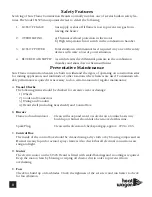
9
Troubleshooting S1505
In order to make these checks an AC Voltmeter is required. Both the control circuit and the motor
voltage is 115VAC. Use extreme caution when checking voltage.
1. Push start button and hold for 2 to 3 seconds.
2. Motor relay and control relay #1 to close simultaneously
1) If motor relay does not close check:
a) If there is power between the coil terminals of the motor starting relay is faulty.
b) If there is no power between these two terminals then proceed to check delay timer.
c) If there is power between terminals 1 & 2 and 2 & 3, but no power between 2 & 6, then
the timer is defective.
d) If there is no power between terminals 2 & 3, of the timer then check the start switch.
2) If control relay #1 does not close then check:
a) If there is power present at terminals A & B of the control relay then the control relay is
defective.
b) If there is no power between these terminals then check the stop switch.
c) If there is power on the common (middle) terminal of the stop switch but no power on
the NC terminal then the stop switch is defective.
3. Fan starts, if not check:
a) If there is power between the black and white wires inside the motor junction box (located
on side of motor) then the motor may need manual resetting. Pushing the red button on
the side of the junction box. If this does not correct the problem then the motor is faulty.
b) If there is no power at these two wire ends then check the motor relay contacts, they may
need cleaning or replacing, if burnt.
4. Fan reaches full speed, airswitch closes, and white light comes on, if not check:
a) If there is power on only one of the airswitch terminals while motor is running, then the
airswitch is staying open. First check if either the upstream or down stream airtubes are
plugged.
b) If both are free then check alignment (tubes must be positioned parallel to the direction of
airflow)
c) If above procedures do not correct problem, then the adjusting screw located on the side
of the airswitch can be rotated counter clockwise, just enough so that the fan stays
running.
5. Control relay #2 closes, if not check:
a) If there is power between terminals A & B of relay #2, if power is present then relay is
faulty
b) If there is power between terminals L1 & L2 of the Fenwall module, but no power 2 sends
after start-up between terminals V1 & V2 of the Fenwall, then the Fenwall module is
defective.


































